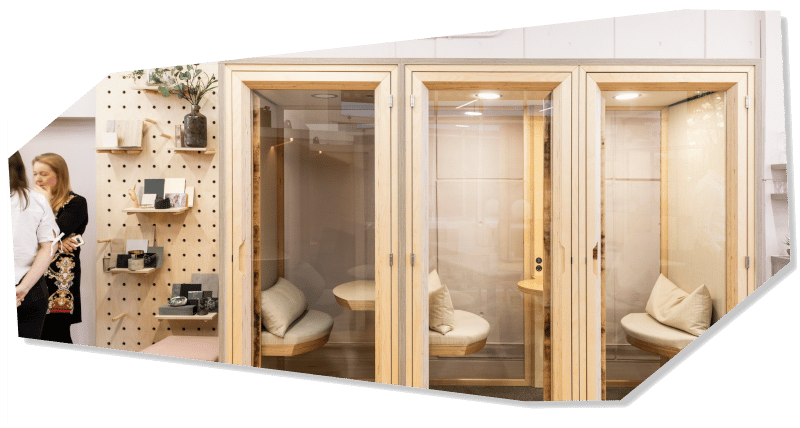It’s time to re-think how we work
The events of the pandemic have focused minds once again on the role of the office, and how it can most effectively support people to do their best work.
The last two years have opened the eyes of organisations across a breadth of industries to the possibilities of different ways of working, with remote and hybrid working being pushed up the agenda. The role of the office has changed, and this shift in where and how people work has opened up opportunities to think differently about how that space is best utilised.
The traditional workplace system of designated desks and inflexible, ill-equipped meeting rooms is clearly no longer fit for purpose. This has been driven in part by the pandemic, but there are other factors that have influenced shifting attitudes as well.
The need to reshape the workspace
Businesses have started to tune in to the untapped potential of the workplace, and the benefits of adopting a more dynamic approach to workspace design. Workplace leaders are seeking to remove obstacles that limit productivity, by reshaping the workspace to provide employees with a range of activity-based spaces that are tailored to the specifics of the work they carry out.
These changes are driving individual and team performance and enhancing collaboration. With the ability to choose where, when, and how they work, employees thrive as activity-based working (ABW) makes it easier for employees to fulfil their roles. This benefits the businesses that opt for more modern working models exponentially. Finding actionable workspace solutions that reform the way the workplace operates has therefore become a focal point for many businesses.
Reconnecting people and organisations
The recent surge in alternative ways of working such as hotdesking and hybrid working gone some way towards meeting these demands. We know employees are no longer willing to come into the office for the office’s sake, only to be met with a system that no longer works for them. This has led to a majority of UK office workers feeling discouraged with the workplace, with 60% stating they’d rather work remotely all the time. To keep businesses connected, productive, and with thriving employees, we need to look at new ways of working.
Activity-based working addresses this demand. It brings a performance-focused approach to the idea of the workspace on various levels. It benefits businesses by optimising productivity and business performance, while rationalising the associated property costs of having an office. ABW is being adopted by a range of organisations looking to support their employees with the best possible workspaces, designed in ways that will empower them to do their best work. Reducing costs while improving employee performance, the business-related benefits of ABW are undeniable.
What is Activity-Based Working?
Activity-based working focuses on the idea that each location within an office should function to suit a different work-based activity. Rather than the classic office layout featuring regimented desk allocations for everyone, activity-based working understands employees benefit from having multiple tailored environments to work from. The scope of tasks each employee is required to undertake within the span of just one day means they’re subject to ever-changing demands – yet we’ve been providing them with exactly the same workspace throughout.
ABW understands how limiting someone to one designated workspace can also limit the way they perform. It’s about addressing the restrictions caused by typical workspace dynamics and working to change them. ABW is about using innovation to adjust our spaces to suit the way we work – not the other way around.
The revival of the office
Activity based working is not a new concept, though its popularity only started to really gain momentum in recent years. The term was devised after Dutch consultant Erik Veldhoen’s 1994 book ‘The Demise of the Office’, which went on to inspire a range of activity-based working projects. Veldhoen recognised how a changing world required changes to the office environment, particularly with regards to the advances being made in workspace technology.
Today, the increased digitalisation of office-based tasks means businesses are no longer ‘stuck’ with the confines set out by traditional office layouts and settings. Companies are latching on to the idea that a more dynamic approach is the best route for increased business performance.
As we see more offices adapting activity-based working, we expect to see an increased number of businesses thriving as employees return to (and become satisfied within) the office. While recent events have diminished the role of the office from the perspective of employees, the office remains an integral factor in enriching company culture and performance for any business. As activity-based working is now being introduced to the mainstream, the revival of the productive and creative workforce is here.
Optimising workspaces for the future workforce
Activity-based working is not only an innovative way to design offices. It’s an entirely new model of working, with the design of the office adapting to encourage this new approach.
The idea behind activity-based working is that re-designing our work environments to optimise employees’ abilities will benefit business. This contrasts with the typical approach of implementing a top-down working model, and expecting everyone to follow suit.
Activity-based working is best implemented when you optimise the entire design of each respective workspace to suit the activity it’s intended for. Done effectively, this means the ideals behind ABW can be implemented successfully, boosting business performance and employee satisfaction.
Offering a range of different environments your workforce can utilise throughout the day enhances the flexibility of the workplace. Individual desk spaces are no longer expected to cater for such a wide scope of activities, so workers are no longer expected to adapt their surroundings to suit their projects. Instead, the activity-based workspace offers a variety of surroundings that allow employees to seamlessly move from one task to another.
They can do this without wasting time clearing up their desk, moving task-based equipment between areas, or even using up mental effort in psychologically gearing themselves up for the next task despite remaining in the exact same space as before. Productivity increases, and business performance is optimised.
What about the traditional workspace?
The question ABW asks is, essentially, does the traditional workspace still work for us? Classic office elements like desks play such an integral role to our typical workday that it can be difficult to imagine different office setups with alternative designs.
Despite this, Gallup Chairman Jim Clifton estimates that 37% of office desks will remain empty despite large numbers returning to work throughout 2022. This suggests that the way we’re working is evolving so much, our office environments should also follow suit.
ABW does not advocate for the abandonment of classic aspects of the office. Solo work is still necessary across a range of situations. The solution is to switch to a more efficient means of providing workspaces, such as hotdesking, hotelling, and neighbourhoods. This saves space in reducing the number of unused desks, providing opportunities to design more functional areas within the office that suit the modern workforce.
Some may feel disheartened at the idea of losing their individual workspace, as it’s a dedicated space employees can claim ‘ownership’ over within a building that may contain thousands of employees. However, the enhanced degree of control and customisation an employee has within a dynamic ABW environment certainly makes up for this.
How Office Workspace can help
The first step as simple as having an informal chat with one of our workspace team, to find out a bit more about your business and your drivers for change.
To find out more about how we can help you to innovate the way you work, get in touch by emailing hello@officeworkspace.com or calling +44 (0)20 8039 0000. You can also fill out our online contact form, and we’ll get back to you as soon as possible.

